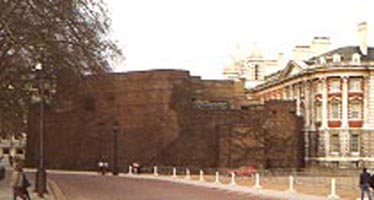"In September [1941] it was agreed that the elements of the Air Ministry
staff would move to the Horseferry Road at the end of the year. The following
April the Chiefs of Staff and Sir John Anderson proposed that the GHQ Home
Forces should also go to Horseferry Road. The construction of the extension
of the Whitehall Deep Tunnel to this citadel was completed in August 1942
and GHQ Home Forces, had actually moved there by November."
CWR booklet-Simkins p50
Government departments under Broad Sanctuary and Great Smith Street.
The tunnel was extended to Horseferry Road Rotunda. Churchill equipped
the complex with Lamson Pneumatic tubes.
London Under London p18
"The engineer was Brigadier James Orr who died in 1993. Awarded the
OBE but due to the nature of the work was not given a citation."
Secret London - Duncan p44
The Cabinet War Room and Goodge Street Deep Shelter were linked by Lamson
Tube document transportation system.
Spy's London - Berkley p46
 ...the
Admiralty blockhouse in Pall Mall (sic) ...Churchill called it "The vast
monstrosity which weighs on the Horse Guards Parade"
...the
Admiralty blockhouse in Pall Mall (sic) ...Churchill called it "The vast
monstrosity which weighs on the Horse Guards Parade"
"...a tunnel runs from Buckingham Palace under the Mall to a massive
underground citadel, known as Q-Whitehall, which lies 100 feet under Westminster
and Whitehall and extends as far north as Holborn. Evidence for this includes
a huge extractor fan just outside the Gent's loo at the Institute of Contemporary
Arts - directly above the supposed site-which the ICA confirms is nothing
to do with them. The ICA building is immediately opposite a huge top security
fortress building, on the corner of the Mall and Horse Guards Road, which
is generally accepted to be the service access to Q-Whitehall. It is also
known that a tunnel connects Downing Street to a massive atom bomb-proof
bunker constructed under the Ministry of Defence building in the early
nineties at a cost in excess of £100 million. It is likely that this
building connects directly with Q-Whitehall."
David Northmore,
London N6.
Extract from Guardian, Notes & Queries, April 2 1997
"There was an untidy, clattering bustle; hardly one of the small rooms
had less than two telephone conversations going on; officers and civilians
and 'secret ladies' moving about the narrow corridors with heavily labelled
folders and dockets, teleprinter flimsies or illegible sequences of decoded
signals. There was a smell of rooms never empty for more than a few minutes,
usedall round the clock. The Citadel quarters were admirably clean.
ventilated and warmed by the standards of those days, but cut off by twenty
feet of steel and concrete from the fresh air of St James's Park and the
Mall. Indeed, it was probably the best bomb-proof headquaters in London.
Six hundred yards away to the south in Storey's Gate, the Prime
Minister might sometimes wonder during the Blitz whether a direct hit might
not bring the Thames flooding into his basement shelter. Not so the hundred
men and women of the OIC (Operational Intelligence Centre) working in the
Citadel,
described by Churchill in his memoirs as that 'vast monstrosity which weighs
upon the Horse Guards Parade'. They had the assurance of safety from even
a direct hit - and a bracing assurance it was - but for it they paid the
price of complete exclusion from the outside world: no windows, on daylight,
no sound of traffic or birds or wind, only the noise of the work being
done. It was the engine room of NID (Naval Intelligence Division)."
Extract from:
"Room 39 - Naval Intelligence in Action 1939-45" by Donald McLachlan
has a good description of the use of the building during the Second Worl
War.
In use in 1967 by the ROC (Royal Observer Corps school).
"In 1941 the tanks were converted into two heavily reinforced underground
strongholds each equipped to house several thousand Government officials
in absolute safety from enemy attack for up to two to three months. These
were joined by a tube railway to similar strongholds in Whitehall [Montague
House] and the Mall [The Admiralty Blockhouse].
BtCS p199
"...the government received advance warning ....of attack by flying
bombs and rockets."
In July and August 1943 plans were made to prepare the basement of
the North Rotunda at Horseferry Road for possible use by the Prime Minister,
his personal staff and a nucleus of the War Cabinet Secretariat. These
quarters, codenamed ANSON, were ready on the 15th November but in
February 1944 Churchill repeated that he had no intention of moving unless
London suffered a scale of attack far worse than anything expected to date."
CWR-booklet-Simkins p60
The building is mentioned by Pevsner;
"Government offices, Marsham Street and Horseferry Road. The architect
was Eric Bedford an association with Robert Atkinson and Partners, built
1963-71. A vast job with 450000 ft of office space for 3600 civil servants.
3 slabs 200 ft high and 5 connecting wings projecting to the street. The
ground floors are on stilts."